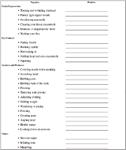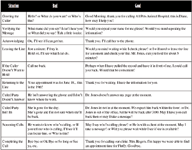Communication: The key to success (Proceedings)
Effective Communication - Communication is an Underrated Art
I. Effective Communication — Communication is an Underrated Art
a) Integral Components
• Verbal
• Non-Verbal
• Written
II. Verbal Communication
a) Tone of Voice
b) Timing
• How timing can be used
c) C. Atmosphere
• Normal client interaction
• In-hospital problem situations
d) D. Speech Clarity
e) E. Succinctness
• Verbose
• Pointed discussions
f) F. Why Clients Stop Coming to Our Practices
_______ % Die
_______ % Move
_______ % Change Because of a Friend's Recommendation
_______ % Competition
_______ % Dissatisfied with Product or Service
_______ % Attitudes of Indifference by Some Employees
g) G. Customer Complaint Behavior
- The TARP Study
• 96% of unhappy customers do not contact the business that upset them. For every complaint received, the average company has 26 customers with problems, 6 of which are "serious."
• Complainers are more likely than non-complainers to do business again with the company that upset them, even if the problem isn't satisfactorily resolved.
• Of the complainers, between 54 and 70 percent will do business again if the complaint is resolved.
• 95% of customers will do business with a company again if they feel their complaint was quickly resolved.
• Complainers who have had complaints satisfactorily resolved tell an average of five people.
• The average customer having a problem tells 9 to 10 people about the incident; 13% will tell more than 20 people.
h) H. People Want To Talk To People Who:
1. Appreciate Them
• Show appreciation; tell them what you appreciate
• Use the words: "I appreciate...", "Thank you for..." or "It helps me when you..."
• Everyone wants to hear they are important and appreciated
• Always be polite
• No judging
• No challenge
• No name calling
• Use suggestions: "Did you notice...?"
• If face to face, when a person approaches the desk, show interest by looking up, standing up, or approaching the person and asking, "How may I help you?"
2. Understand Them
• Don't stop at the words, "I understand..."
• Continue with WHY you understand
Use the same words they used; repeat them
• Name the feelings: "I understand you are upset that your check hasn't come."
• Give the reason why they are upset
• Sympathize — use a personal remark
• Ask questions to get more information
• React positively to the client non-verbally with gestures, facial expressions, or tone of voice
• Respond clearly with answers that are easily understood; avoid jargon
• Remain non-judgmental and objective
• Remember, if the client is angry, you are not at fault
3. Will Help Them
• Say it: "I will try to help you..." or "I will find out for you..."
• It only takes a minute longer to really try to help
• Never refer to company policy
• Go the extra mile
• Volunteer information up front before the client or customer can ask for it
• If you don't know, say so: "I don't know, but I will try to find out."
• "However," "but,", "so," "any" —all are conditioning words
4. Use Their Name
• The sweetest words in the language are a person's name, so use it: "Yes, Mr Smith..." or "Mrs. Jones..."
5. Are Creative
• Try to help
• Control the conversation by using concepts
6. Are Honest
• If you don't know the answer, say: "I don't know."
• Give personal remarks where appropriate
• Don't fake a sugary sweet voice, but always be pleasant
7. Listen To Them
• Communication Behavior
_______ % Writing
_______ % Reading
_______ % Speaking
_______ % Listening
III. Listening Skills
a) Identify Purpose of Communication
• Persuasive
• Informative
• Sharing
• Social
b) B. To Listen Actively
• Focus eyes
o On person, if face to face
o On paper or CRT, if at desk or on the phone
• Be mentally alert
• Overcome distractions
• Ask open-ended questions
o Who, What, Why, Where, When
• Prepare in advance
o Have script ready
o Have file ready
o Think of remarks and questions in advance
• Turn off your own worries
• Interject listening responses such as "I See..." and "Yes"
• Listen for ideas
• Limit your own talking
• - From time to time, try to clarify what has been said by making a statement or rephrasing the question
c) C. Listen For Comprehension
• Alternate speaking with listening in order to clearly understand the question; interrupt only to ask a question
• Limit your own talking
• Think like the client — remember to keep his/her point of view in focus
• Make notes
o Write as client talks
o Clarify what you have written
• Work at meaning
• Ask questions
• Don't engage in other tasks while talking to clients; give your full attention to the other person while he/she is speaking
d) D. React To Ideas
• Control emotional reactions
• React to ideas — not to the person
o Don't become irritated at things he/she may say or at the manner in which they say it
• Don't jump to conclusions
o Avoid making unwarranted assumptions about what the client is going to say
o Avoid mentally trying to complete the client's sentences
o Remain non-judgmental and objective
IV. Non-Verbal Communication

V. Written Communication
a) Appropriate Means
• Care of Your Pet Following Hospitalization (Discharge Order)
• Medical Care Plans
• Surgical Consent Form
• Pre-Exam Checklists
• Lifetime of Wellness
• Puppy, Kitten & Exotic Biographies
VI. Telephone Etiquette
a) The First Client Contact
b) Good and Bad Responses
c) C. How to Use the Telephone Conversation to Your Advantage

VII. Client Communication
a) What are the Most Appropriate Forms of Communication for:
• Policy changes
• Changes in hospital procedures
a) B. Levels of Communication
• Defining that level (carefully!)
o Arbitrary
o Infantile versus intelligent
o Pseudo intelligent